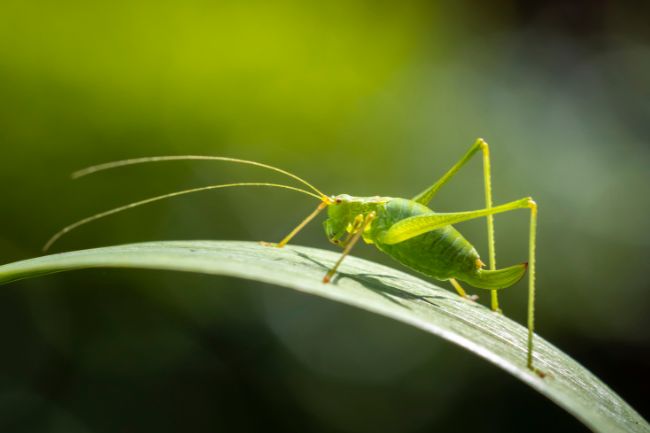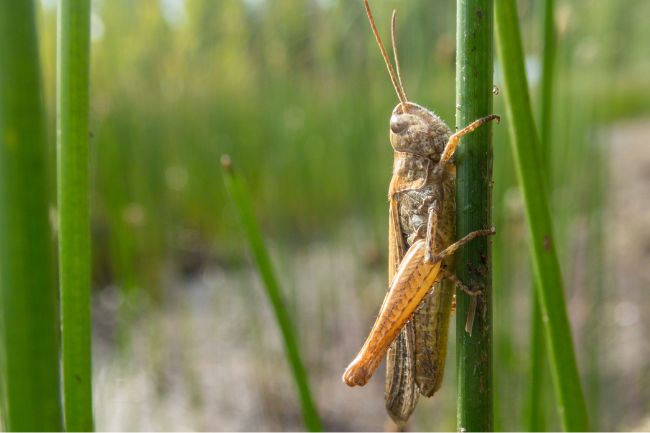Whether insects feel pain is a long and hotly debated topic. The truth is we simply don’t know, but it is likely that whatever they do experience is very different from us.
Understanding whether an animal can experience pain is very significant for how we treat them. If they can feel pain it has ethical implications for how we keep them and treat them.
Crickets are often used as live food, or bred in crowded conditions, if they can feel pain then how they are treated would need to be reviewed to ensure it was humane.
Sensory Systems in Crickets

Crickets have a range of sensory organs. They have eyes which allow them to see, antennae to pick up a wide range of stimuli, including heat, wind direction and chemical signals, and ears to detect sound.
The sensory organs within crickets are there to help them detect possible danger, find food and locate mates. All of this helps them to remain safe, be well-fed and successfully breed.
Also read: Do Ladybugs Have Antennae? (The Ways They Can Use Them)
Pain Perception in Crickets
Scientific communities disagree on whether insects can feel pain or not. It’s very difficult to know what a living being so different from ourselves might feel.
The argument against insects feeling pain is driven by the concept that they are much simpler organisms than ourselves, with less complex nervous systems and brains.
Pain in humans and other animals is argued to be part of the learning process, helping individuals to adjust their future behavior to benefit the species in the long-term.
| Experiment | Stimulus Applied | Cricket Response |
|---|---|---|
| Hot Probe Test | Heat applied to leg | Sudden leg movement, flicking |
| Pinch Test | Mechanical pressure | Quick withdrawal, escape |
| Acid Test | Acidic solution application | Grooming, grooming pause |
In insects, their lifespans are much shorter, and most appear to lack the ability to pass on learning to future generations. It’s therefore argued that their behavior is more directly linked to their genetic code, rather than learning. With no ability to learn, pain is an unnecessary burden for these fast-living insects.

Conversely some insects have been shown to be able to display complex behaviors, that indicate abilities to learn, pass on knowledge and recognise each other. All this indicates a high level of intellegence that suggests a much more complex mind than we often give them credit for, something that could include feeling pain.
Also read: Here’s “How Earthworms Feel Pain” (Nervous System Explained)
Nociception in Crickets
Nociception is the process by which organisms can detect noxious stimuli, so for example sensing that temperatures are becoming high or low enough to become detrimental.
Sensing these stimuli, the body will then respond, however, this is different from the feeling of pain, which is an emotional response.
Within insects nociceptive responses are common, such as worms writhing when cut in half. In crickets their response can be to try to get away from the discomfort, but they also have the ability to shed their limbs if it might help them survive overall.
| Indicator | Neural Activation | Behavioral Response | Interpretation |
|---|---|---|---|
| Nociceptors | Activated by harmful stimuli | Sudden leg movement, escape | Suggests potential pain perception |
| Central Nervous System | Signal processing and response | Behavioral changes | Neural processing of potential pain |
| Grooming Behavior | Intense grooming and pauses | Altered grooming patterns | Potential pain-induced distress |
Behavioral Responses
Crickets are on the menu for a wide range of animals, including humans. Their response to attempts to hurt or catch them is to try to escape, moving away from the threat. However, there is an argument that this is an instinctive response, rather than a response to pain.
Crickets, as with many insects, have a ventral cord that acts like our signal cord, and could send information back along their neurons to show that painful stimuli have been received.
Experiments in different insect species have given results that indicate both that insects do and don’t feel pain. Some experiments have shown insects to show no preference for an environment where they are and aren’t feeling discomfort, while others have shown insects wanting to leave.

Very little research seems to have been specifically carried out on crickets, meaning we cannot be certain yet if they do have this capability.
Examples can be seen of crickets continuing to eat, while they themselves are being eaten, something that would suggest they are not feeling pain.
Also read: The Diversity of What Crickets Eat
Neurological Structure and Complexity in Crickets
As with many insects, crickets don’t leave all their decision making to their brain. Rather than one big brain and a spinal cord to collect and send out all the their necessary signals, they have a series of ganglion located throughout.
Ganglia are collection of cells, that help control certain functions in the cricket’s body, such as moving their wings, or legs. These mini brains help to speed up the cricket’s reactions as signals don’t have to go all the way up to the cricket’s brain to be processed.
When reacting to a predator, such speedy thinking can be a life saver. Crickets do still have a brain, however this larger data processor is responsible for processing the massive amounts of data from the cricket’s eyes and antennae.
All of these have to be connected together in order to coordinate the individual responses so they correctly function as one unit.
| Insect Species | Pain Experiment | Notable Findings |
|---|---|---|
| Honeybees | Proboscis extension reflex | Demonstrated potential pain-like response |
| Fruit Flies | Escaping heat and touch | Showed evidence of perceiving harmful stimuli |
| Crickets | Varied pain tests | Inconsistent responses warrant further study |

Also read: Do Ants have Brains? The Purpose of Ganglia Explained
Frequently Asked Questions
- Do crickets experience pain like humans or other animals?
Currently we can’t be certain whether crickets feel pain as we do. Certainly the more we study insects the more complex and intelligent they appear to be. - Can crickets feel pain in response to injury?
If crickets do feel pain, it’s most likely they would experience it due to an injury. - How do crickets react to potentially harmful stimuli?
Crickets react differently depending on the stimuli, however they often choose to avoid danger by moving away from any negative stimuli. - What are the limitations of current scientific knowledge on this topic?
Currently, some research suggests that some insects experience pain, while other research suggests they don’t. More studies specifically into crickets needs to be carried out. - Should ethical considerations guide our treatment of crickets?
Animal cruelty was once seen as a fact of life, largely because animals weren’t believed to feel much at all. Today we know animals feel pain as we do, and those that treat them cruelly are considered criminal. If crickets do feel pain, then their comfort should also be paramount in the future.
Conclusion
There is currently a lot of uncertainty when it comes to understanding whether crickets can feel pain. The good news is that science is advancing fast, with our understanding of pain in insect species developing rapidly. Maybe the answers aren’t too far away.
With crickets being farmed both for human and animal consumption, it’s important to understand what they think and feel to ensure we treat them humanely.
The anatomy of insects is very different from our own, making it a complex topic to pick apart. With scientific experiments showing us that some insects do react to pain as we would there’s a good chance that crickets do feel pain. We’ll just have to wait and see when science can give us the answer.

